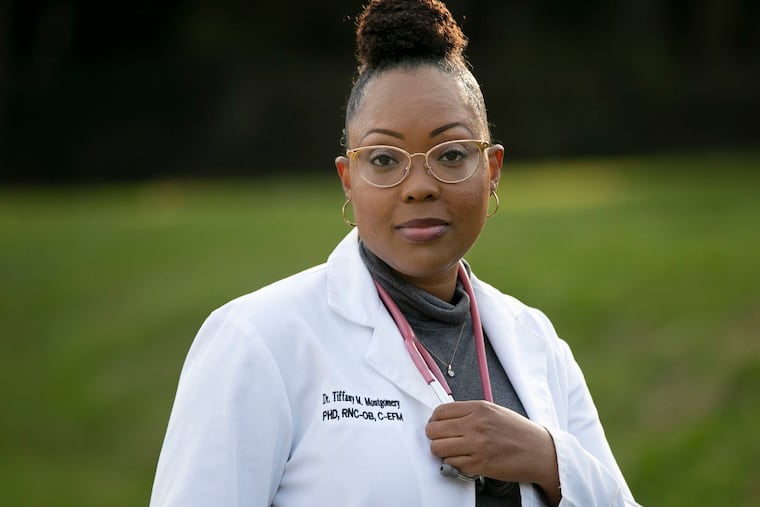Real health-care equity means diversity everywhere — including nursing school faculty | Opinion
Health care outcomes are demonstrably better for patients who see themselves in their providers. Yet, disparities continue to be stark, especially in academic settings.

I was as nervous as I could be when I walked into the classroom on my first day of nursing school. There were at least 150 of us crammed into a space meant for far fewer. But being so packed in also made it possible to take quick stock of my colleagues.
I looked around.
There’s one, I thought.
There’s another one.
Before long, I discovered that there were seven Black students in the spring 2005 nursing class. Two men and five women. Seven out of 150 made for a little under 5%. It wasn’t much, but it was better than the 3% of us represented throughout my California university.
Even worse, of the 30 or so full-time, tenure track undergraduate nursing faculty at the university, none was Black.
» READ MORE: A Black physician who understands COVID-19 vaccine skepticism explains why he’s getting the shots
This lack of diversity mattered every day, but never more so than during our first clinical rotation. A white patient told one of my Black classmates that she was OK having a Black nurse, and to demonstrate how open-minded she was, the patient declared she let a “n— boy” cut her lawn.
My classmate was devastated. I was devastated for her. But we had no mentor to turn to who could truly understand what we were experiencing.
The following year, my classmates and I gave culturally specific maternal health presentations. In a gross misinterpretation of the eating disorder pica, one of my classmates exclaimed, “Black people eat dirt!” Our professor asked me about the accuracy of this statement. I was mortified. What would make my classmate believe Black people eat dirt? And why wasn’t my professor culturally aware enough to call her out? Why did she call on me to be the spokesperson for all Black people?
These and other racially charged experiences led me to pursue a career as a nurse educator because I wanted to help diversify nursing faculty. I didn’t want future Black nursing students to feel the way I felt. I wanted them to have a faculty member with a shared ethnic background and cultural roots. I didn’t want them to feel alone.
There are nearly four million registered nurses in the United States. Ten percent of us identify as Black or African American, which is not far off from the 12% of Black residents living in the U.S. But when we look at the number and rank of Black nursing faculty, the racial disparity is evident.
Nine percent of U.S. nursing faculty are Black. Thirty-nine percent of Black faculty are assistant professors and 14% are associate professors, compared to 28% and 15% of white nursing faculty. This suggests that white nursing faculty are successfully promoted from assistant to associate professor, at almost twice the rate of Black faculty. Locally, the disparity worsens.
By my calculation, there are 307 faculty listed on the webpages of the five Philadelphia universities offering bachelor of science in nursing programs. Only 19 of these faculty are Black. So while upward of 40% of Philadelphians identify as Black, 6% of the city’s nursing faculty reflect the same racial identity. Six percent in a city of 40%.
Make it make sense.
Six of the 19 Black nursing faculty in Philadelphia universities are tenured; three full-tenured professors, three associate professors. There is but one Black man among them. That’s right, one Black male nursing faculty member out of 307. In a city of more than 300,000 Black men and boys. One.
Make it make sense.
By failing to have a citywide nursing faculty that is representative of our residents, we are failing Philadelphians. Black Philadelphians.
We know that patients of color often prefer health-care professionals with the same self-identified race and ethnicity. We know patients who find such help are more likely to utilize health care, leading to better health outcomes and lower future health costs. We know that diverse faculty facilitate the retention of diverse students, yet faculty diversity rates do not often reflect student diversity.
The coronavirus pandemic has brought these issues to the forefront. Communities of color have suffered far higher rates of serious illness and death than others. And despite the FDA approval of two effective COVID-19 vaccines, Black Americans tend to be skeptical of the shots, in many cases because of negative experiences with health-care providers and systems that have not always had our best interests in mind.
Increasing the percentage of Black nursing faculty in Philly will make a bold statement about the importance of racial diversity in the city. We must implement effective strategies to recruit and retain diverse nursing faculty. We cannot explain away 6% in a city of 40%.
As the birthplace of our country, the home of world-renowned universities and hospitals, and the city that helped place the first vice president of color in the White House, our city leads in so many ways. Let’s also lead in the effort to produce a nursing workforce that reflects the residents of our city and the patients under our care.
Tiffany M. Montgomery is a registered nurse and Drexel University postdoctoral research fellow. She told a version of this story at the Inquirer’s “Telling Your Health Story” event; see the video at inquirer.com/blacknurses.